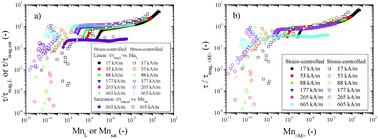Testing the mean magnetization approximation, dimensionless and scaling numbers in magnetorheology
Abstract
The mean magnetization (MM) approximation is undoubtedly the most widely used approximation in magnetorheology both from theoretical and simulation perspectives. According to this, spherical magnetizable particles under field can be replaced by effective dipole moments m placed at their center with strength m = Vp〈Mp〉. Here Vp and 〈Mp〉 are the volume and mean (average) magnetization of the particles, respectively. In spite of being extensively used, there is not a mathematical justification to do so in most cases. In this manuscript, we test this approximation using experiments, theories and simulations, for a wide range of magnetic field strengths and particle loadings, in both conventional magnetorheological fluids (CMRFs) and inverse ferrofluids (IFFs). Results demonstrate that the MM approximation is applicable in IFFs for a very wide range of field strengths (up to external fields of 265 kA m−1) and particle loadings (up to 20 vol%). For CMRFs, the MM approximation is only applicable in two particular circumstances; in magnetic saturation or in infinite dilution.


 Please wait while we load your content...
Please wait while we load your content...